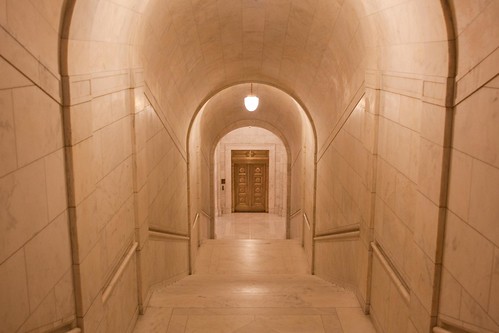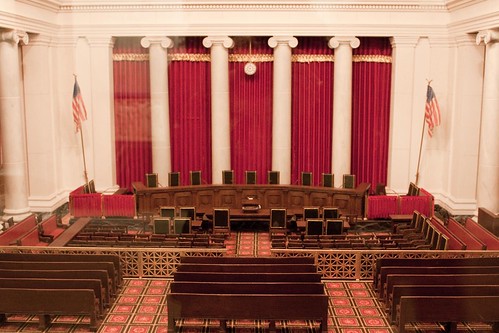By far the coolest DC experience is seeing a Supreme Court Oral Argument. I mean, if you’re some kind of political/DC junkie. Which you totally are if you’re reading this.
Let’s do this.
The Supreme Court’s oral arguments are open to the public, on a first come/first serve basis. For controversial cases, like the recent healthcare case, people wait in line for days. Or, hire people to wait in line for them for days. Sleeping bags and tents are involved.
But, for cases that haven’t been talked about to death on CNN or Fox News, you can line up the morning before the argument.
The Supreme Court holds oral arguments throughout the year, when they are in session. The Supreme Court usually hears one or two cases a day, with the first case beginning at 10am and the second at 11am. Here are calendars that tell you if oral arguments are being held on any given day (oral arguments days are in red): click here for 2012 and here for 2013.
If any of those dates match the days you’ll be in DC, check out this link for a list of cases that will be heard each month. Click on the month you’ll be in DC, and you’ll get a mini calendar of the cases that will be heard on any given day.
Click on the hyperlinked docket number to see more information about the case, like what it’s about, what the legal questions are, and what happened to the case in the lower courts.
[If you actually want to see the briefs submitted to the Supreme Court, go to the American Bar Association’s Supreme Court Brief’s page and search for the case you’ll be going to. The list is alphabetical by case name, but you can also use the docket number to find your case.]
OK! So now you know which cases you’ll be able to see. How do you actually get in?
Before we begin, know that there’s kind of a dress requirement if you’re going to see the Supreme Court. No “inappropriate” clothing. Not sure what this means, but it’s probably your best bet to dress at least corporate casual.
1. On the morning of the case you’d like to see, head to the Supreme Court building. It’s across the street from the Capitol Building. Get there early.
2. You’ll have to line up in one of two lines — the full oral argument line and the three minute line. The three-minute line will pass before the Courtroom for three minutes, just so you can see the Justices and get a taste of what goes down in an oral argument. If you’re confused about which line is which, definitely ask one of the cops — they are super friendly.
3. The lines will start moving about a half hour before the argument begins. You’ll go through ground floor security and then get ushered upstairs. You’ll have to go through a second round of security upstairs.
A catch is that you can’t bring anything into the Courtroom with you. Not only cell phones, but sunglasses or really anything. You’ll have to either come empty handed or check your coat and bags in the cloakroom upstairs. They have lockers too, if you’d rather lock up any valuables. Bring quarters.
4. Alright! So, now you’re inside. Now what?
First, who’s who. The Justices are a bit more diverse looking then they used to be, so it’ll probably be easy to tell them apart. Here’s a handy map of where each Justice sits. In the center, you have the dapper Chief Justice John Roberts. Also keep an eye on Justice Anthony Kennedy, the swing voter in the bunch. He sits just to Chief Justice Roberts’ left. Justices Sotomayer and Kagan, the newest members, are on the ends. (Justice Kagan, as the newest Justice, is also the official Supreme Court coffee runner.)
During oral arguments, each side has a half hour to argue their case. But, the Justices can cut them off at any time and pepper them with questions.
You’ll notice that a Supreme Court oral argument is much different than court cases you’ve seen on TV (real or fake). The facts aren’t really at issue at all; all parties are trying to settle a Constitutional question. The lawyers will try to use a plain reading of the Constitution, or refer to previous Supreme Court cases, to try and prove that their interpretation of the Constitution is the correct one.
The Justices, though, aren’t beholden at all to whatever the lawyers are arguing and are wholly free to throw in questions from left field. And they totally do. They may think that a lawyer has left out or ignored an important relevant legal precedent. Or, they might even be trying to help out a lawyer by presenting them with a better argument. If you’re a dork, part of the fun of an oral argument is seeing how well the lawyer is able to bounce and weave with the Justices.
Don’t worry if you have trouble following along. I sometimes get the feeling that there are only nine people in that Courtroom that have any idea what’s going on.
[If you are in town while the Supreme Court is not in session, don’t despair. The building is open to the public, through a north door just to the side of the grand stairs. They have a really well done exhibit on the ground floor that will make your heart feel all warm with freedom and justice. The building also holds open-to-the-random-public lectures in the Courtroom on the half hour, every hour. The guards let me wander upstairs and take a look around without joining the lecture too — as I said, everyone is really friendly.]












Guest City: Washington, DC – Vacationing with Nancy, Barbara, and Ruth: An Insider's Guide to DC | Far Out City
[…] 3. Attend a Supreme Court Oral Argument […]
4/10/2012 at 6:00 pm